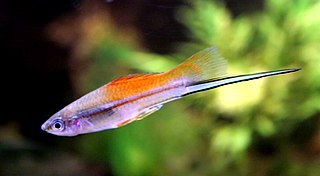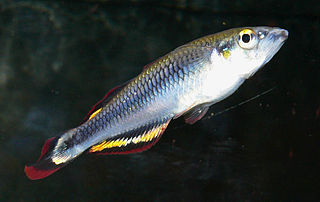
Poeciliidae are a family of freshwater ray-finned fishes of the order Cyprinodontiformes, the tooth-carps, and include well-known live-bearing aquarium fish, such as the guppy, molly, platy, and swordtail. The original distribution of the family was the Southeastern United States to north of Río de la Plata, Argentina, and Africa, including Madagascar. Due to release of aquarium specimens and the widespread use of species of the genera Poecilia and Gambusia for mosquito control, though, poeciliids can today be found in all tropical and subtropical areas of the world. In addition, Poecilia and Gambusia specimens have been identified in hot springs pools as far north as Banff, Alberta.

Xiphophorus is a genus of euryhaline and freshwater fishes in the family Poeciliidae of order Cyprinodontiformes, native to Mexico and northern Central America. Xiphophorus species can be divided into 3 groups based on their evolutionary relationships: platyfish, northern swordtails, and southern swordtails. Platyfish formerly were classified in another genus, Platypoecilus, which is now obsolete. The type species is X. hellerii, the green swordtail. Like most other new world Poeciliids, platies and swordtails are live-bearers that use internal fertilization and give birth to live young instead of laying eggs like the bulk of the world's fishes. The name Xiphophorus derives from the Greek words ξίφος (dagger) and φόρος (bearer), referring to the gonopodium on the males. All are relatively small fishes, which reach a maximum length of 3.5–16 cm (1.4–6.3 in) depending on the exact species involved.

Poecilia is a genus of fishes in the family Poeciliidae of the order Cyprinodontiformes. These livebearers are native to fresh, brackish and salt water in the Americas, and some species in the genus are euryhaline. A few have adapted to living in waters that contain high levels of toxic hydrogen sulfide and a population of P. mexicana lives in caves.

Rainbowfishes are small, colourful freshwater fishes belonging to the family Melanotaeniidae, found in northern and eastern Australia, New Guinea, Sulawesi and Madagascar.

Vieja is a genus of cichlid fish from Central America and Mexico. The majority of the species are freshwater fish found in stagnant or slow-moving waters of southern Mexico to El Salvador, but V. maculicauda, which also occurs in brackish waters, ranges south to Panama. They are high-bodied cichlids that reach lengths of up to 17–35 cm (7–14 in) depending on the exact species. Vieja feed mostly on vegetable matter, but may also take small invertebrates.

Astroblepus is a genus of fish in the family Astroblepidae found in South America and Panama. This genus is the only member of its family. These catfishes are primarily found in torrential streams in the Andean area. Astroblepus pholeter and A. riberae are troglobites adapted to living in subterranean water systems. These species are typically small, less than 10 cm (4 in). The largest species reaches 30 cm (1 ft). These fish have suckermouths like those of loricariids. They have two pairs of barbels, maxillary and nasal. The dorsal fin spine lacks a locking mechanism. These fish also have odontodes, tiny teeth on their skin. All species exhibit a conical, pointy type on their fin rays like that found in other loricarioids; other species also exhibit a blunt type that is only found on their skin.

Bedotia is a genus of the family Bedotiidae of fishes endemic to Madagascar.

Poeciliopsis is a genus of poeciliid fishes that primarily are native to Mexico and Central America. The only exceptions are P. turrubarensis where the range extends into Colombia, and P. occidentalis where the range extends into Arizona and New Mexico.

Micropoecilia is a genus of poeciliids native to fresh and brackish water from the Amazon Basin to Trinidad. While recognized as valid by FishBase, others have considered this genus as being synonymous with Poecilia.

Betta is a large genus of small, active, often colorful, freshwater ray-finned fishes, in the gourami family (Osphronemidae). The best known Betta species is B. splendens, commonly known as the Siamese fighting fish and often kept as an aquarium pet.

Schizopygopsis is a genus of cyprinid fish. Most species are endemic to river basins in the Himalayas and Qinghai–Tibet Plateau of China, but S. stoliczkai extends into the highlands of Afghanistan, Iran, northern India, Kyrgyzstan, Pakistan and Tajikistan.

Loaches are ray-finned fish of the suborder Cobitoidei. They are freshwater, benthic (bottom-dwelling) fish found in rivers and creeks throughout Eurasia and northern Africa. Loaches are among the most diverse groups of fish; the 1249 known species of Cobitoidei comprise about 107 genera divided among 9 families.

Cnesterodon is a genus of poeciliids native to South America.
Priapichthys is a genus of poeciliid fishes native to Costa Rica, Panama and Colombia.

Austrolebias is a genus of killifish in the family Rivulidae. These annual killifish live in temporary pools, swamps and streams in the Río de la Plata, Patos–Mirim and Mamoré basins in South America.
Cynodonichthys is a genus of freshwater killifish in the family Rivulidae. They are found in Middle America, ranging from southern Mexico, through Central America, to Colombia. They are non-annual killifish and inhabit small forest streams from the lowlands to an altitude of 1,500 m (4,900 ft).

Cribroheros is a genus of cichlid found in Middle America. These freshwater fish are distributed over most of Middle America, from western Panama to southern Mexico, on both Atlantic and Pacific slopes. Depending on species, their habitat ranges from fast-flowing rivers and streams, to slow-moving or standing water such as ponds and lakes. Although the genus is overall widespread, the individual species tend to have more restricted distributions and some are threatened, especially due to habitat loss and pollution. They reach up to 19 cm (7.5 in) in standard length.

Poeciliinae is a subfamily of killifish from the family Poeciliidae which contains species from the Americas which are collectively known as the livebearers because many, but not all, of the species within the subfamily are ovoviviparous.

Brachyrhaphis roseni, commonly known as the cardinal brachy, is a poeciliid fish from Central America.

Brachyrhaphis rhabdophora, commonly known as the lace brachy, is a poeciliid fish from Costa Rica.



















